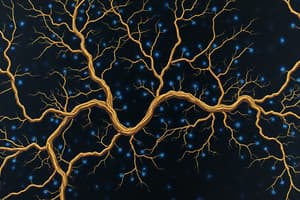Podcast
Questions and Answers
Which neuron is responsible for carrying sensory information from the receptors to the spinal cord?
Which neuron is responsible for carrying sensory information from the receptors to the spinal cord?
- Second-Order Neuron
- Lateral Spinothalamic Neuron
- Third-Order Neuron
- First-Order Neuron (correct)
What is the primary function of the Gracile Tract?
What is the primary function of the Gracile Tract?
- Carries proprioception and fine touch from the lower part of the body (correct)
- Carries pain and temperature sensations
- Carries sensations from the upper part of the body
- Carries crude touch and pressure
Where do second-order neurons typically decussate in the sensory pathway?
Where do second-order neurons typically decussate in the sensory pathway?
- At the cerebral cortex
- In the spinal cord or medulla oblongata (correct)
- In the dorsal root ganglion
- At the thalamus
The Lateral Spinothalamic Tract is primarily responsible for which type of sensation?
The Lateral Spinothalamic Tract is primarily responsible for which type of sensation?
How do third-order neurons reach the sensory area of the cerebral cortex?
How do third-order neurons reach the sensory area of the cerebral cortex?
Which type of sensation is carried by the lateral spinothalamic tract?
Which type of sensation is carried by the lateral spinothalamic tract?
What percentage of fibers in the pyramidal tract crosses to the opposite side at the medulla?
What percentage of fibers in the pyramidal tract crosses to the opposite side at the medulla?
Which structure is NOT part of the limbic system?
Which structure is NOT part of the limbic system?
Which cranial nerve nucleus does NOT receive bilateral corticobulbar input?
Which cranial nerve nucleus does NOT receive bilateral corticobulbar input?
What is the primary function of the rubrospinal tract?
What is the primary function of the rubrospinal tract?
Which region of the brain is primarily associated with olfaction and memory in the limbic system?
Which region of the brain is primarily associated with olfaction and memory in the limbic system?
In which part of the nervous system does the anterior corticospinal tract generally cross over?
In which part of the nervous system does the anterior corticospinal tract generally cross over?
What is the main role of the anterior nucleus of the thalamus within the limbic system?
What is the main role of the anterior nucleus of the thalamus within the limbic system?
Flashcards
Ascending Tracts
Ascending Tracts
Sensory pathways that carry sensations from receptors to the cerebral cortex.
Spinothalamic Tracts
Spinothalamic Tracts
Sensory pathways that carry pain and temperature (Lateral) and crude touch and pressure (Anterior).
Dorsal Column Tracts(Gracile & Cuneate)
Dorsal Column Tracts(Gracile & Cuneate)
Sensory pathways carrying conscious proprioception and fine touch; Gracile for lower body, Cuneate for upper.
First-order neuron
First-order neuron
Signup and view all the flashcards
Decussation
Decussation
Signup and view all the flashcards
Contralateral
Contralateral
Signup and view all the flashcards
Pyramidal Tract
Pyramidal Tract
Signup and view all the flashcards
Corticospinal Tract
Corticospinal Tract
Signup and view all the flashcards
Where does the Corticospinal Tract Cross?
Where does the Corticospinal Tract Cross?
Signup and view all the flashcards
Corticobulbar Tract
Corticobulbar Tract
Signup and view all the flashcards
Facial Nerve Nucleus
Facial Nerve Nucleus
Signup and view all the flashcards
Limbic System
Limbic System
Signup and view all the flashcards
Hippocampus
Hippocampus
Signup and view all the flashcards
Study Notes
CNS Pathways & Limbic System
- The central nervous system (CNS) pathways are complex networks of nerves that transmit information throughout the body.
- Ascending tracts carry sensory information from the body to higher brain centers, while descending tracts carry motor signals from higher brain centers to the muscles.
- Sensory pathways convey sensations like pain, temperature, touch, proprioception, and fine touch using multiple neurons: a primary afferent neuron, a second-order neuron, and a third-order neuron.
- The primary afferent neuron transmits the sensory signal from its receptor to the spinal cord.
- The second-order neuron decussates to the opposite side of the brain stem and ascends within the brainstem as the lemniscus, ending in the thalamus.
- The third-order neuron ascends through the internal capsule and corona radiata to reach the sensory area of the cerebral cortex.
- The dorsal column pathway transmits fine touch and proprioception.
- The spinothalamic tracts transmit pain, temperature, and crude touch.
- The four main ascending tracts are the posterior funiculus-medial lemniscal pathway, spinocerebellar pathway, anterolateral pathway, and spinothalamic tracts.
- The gracile tract carries sensations from the lower body, while the cuneate tract carries sensations from the upper body below T6.
- The corticospinal tract is a descending tract that originates in the motor cortex and controls voluntary movements of skeletal muscles.
- Eighty percent of fibers in the corticospinal tract decussate at the medulla, becoming the lateral corticospinal tract.
- Twenty percent remain uncrossed, forming the anterior corticospinal tract.
- Corticobulbar tracts control voluntary movements of muscles associated with cranial nerves.
- The limbic system is a group of interconnected brain structures involved in emotions, memory, and instinctual behaviors.
The Limbic System
- The limbic system is a collection of interconnected cortical and subcortical structures at the medial side of the brain hemispheres.
- Key components of the limbic system include the limbic lobe, hippocampal formation, prefrontal cortex, hypothalamus, anterior thalamic nuclei, amygdala, and septal areas.
Studying That Suits You
Use AI to generate personalized quizzes and flashcards to suit your learning preferences.




